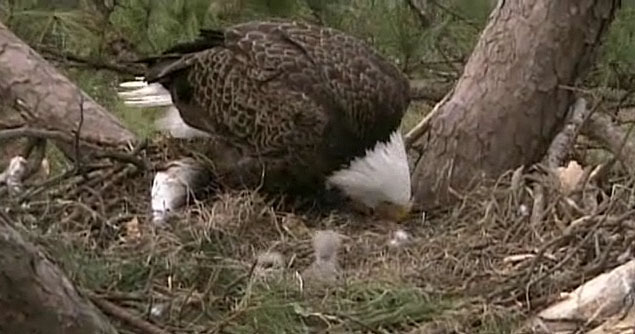
Through both Ophelia Benson and Jerry Coyne this morning, I found out that the mother eagle we’ve been watching raise her brood on the EagleCam at Norfolk Botanical Garden, collided with a plane and was killed yesterday morning. The father is still around, but three is a large brood for eagles, and usually both parents are kept busy cycling the food to the rapidly growing youngsters.
In light of this, wildlife biologists at the Department of Inland Fisheries and the US Department of Fish & Wildlife elected to remove the young from the nest and transport them to the Wildlife Center of Virginia to be raised by wildlife rehabilitators for later release. If left alone, the likelihood of the single parent keeping adequate food flowing would be very low, and developmental problems, including fratricide among the siblings, becomes very likely. So this morning, they removed the eaglets from the nest, and I captured several clips from the webcam with screen-capture software and put them up on YouTube:
[Note that when I originally edited the video, I thought the mother had been killed the same morning as the removal, but this was incorrect; it was the previous morning.]
I’ve been to the Wildlife Center of Virginia in Waynesboro, and it’s a great place, very progressive and exceptionally organized, unlike some wildlife efforts I’ve seen (and very unlike the one I was employed by.) They have a sophisticated hospital, and instruct veterinarians and local rehabilitators in the practice of effective wildlife rehabilitation – it’s one of the few places with a teaching hospital. Were it not four hours away, I’d be aiming to do more work with them.
I titled this “The lucky ones” because most nests that suffer from the loss of a parent simply would not survive, and this happens constantly where we remain unaware of it. Because of the webcam, as well as the accessibility of the nest, these young eagles got another chance – the vast majority (within any species) would not have. The transportation is traumatic, no doubt, and there are still chances for developmental problems and illnesses, but these guys are much better off no matter how you look at it. Accidents happen, and indeed, this particular female lost a previous mate to another aircraft collision a few years ago. Life is a struggle, but sometimes we can help out a bit, too.
Most wildlife rehabilitation efforts throughout the US are non-profit organizations or individuals, not financed in the slightest by local, state, or federal funds. They can always use your help, so take a moment to drop a donation to the center nearest you, and help raise awareness of wildlife issues at the same time. We’re a big species, we can spare some moola and time.





















































Check out some eagle neighbors along the Skagit.
http://tinyurl.com/3olggz8
That poor tree! I can hear it groaning…
That’s a cluster of eagles I’d like to see. I’m still seeking some decent eagle pics, even though the market’s oversaturated. We have the barest handful in this area.